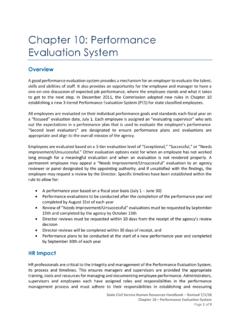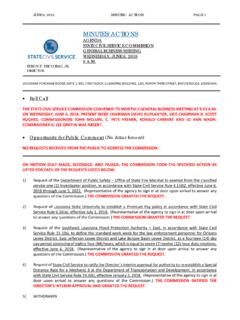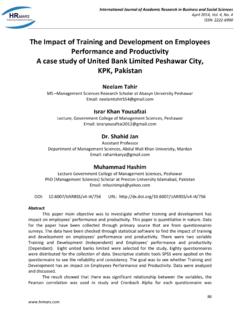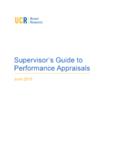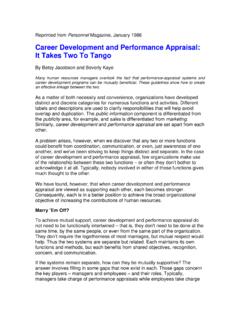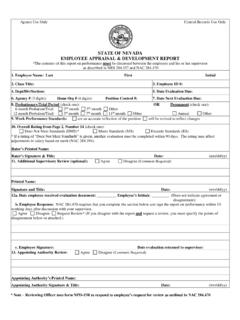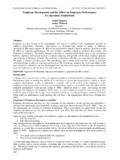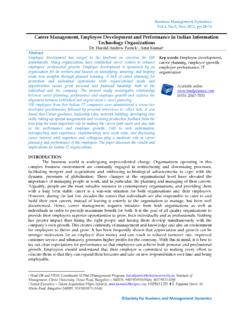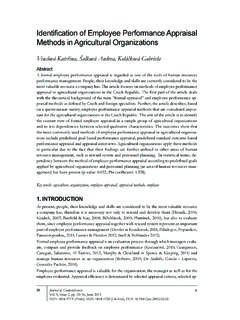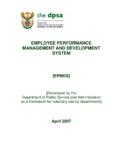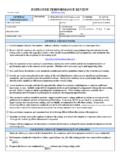Transcription of BUILDING BETTER EMPLOYEE PERFORMANCE THROUGH …
1 Participant s Manual Comprehensive Public Training Program (CPTP) Sponsored by the Louisiana State Civil Service BUILDING BETTER EMPLOYEE PERFORMANCE THROUGH SKILL development 2 BUILDING BETTER EMPLOYEE PERFORMANCE THROUGH SKILL development Participant s Manual Comprehensive Public Training Program (CPTP) Sponsored by the Louisiana State Civil Service Revised 7/11/16 3 SKILL development Course Description Although many agencies invest time, money and energy in various training and development opportunities for their employees, the knowledge and skills gained from training are not always fully applied by the EMPLOYEE on the job.
2 Learning transfer is often impeded by various barriers in the workplace. This course outlines tips and strategies to aid supervisors and managers in achieving BETTER EMPLOYEE PERFORMANCE by ensuring that their EMPLOYEE 's have both the necessary job skills and opportunities for learning transfer. Class participants are encouraged to examine their work environments carefully in order to recognize the factors that may be affecting worker PERFORMANCE . Job Outcomes Provides opportunities for EMPLOYEE orientation, training and development Learning Objectives Define supervisor s role in EMPLOYEE development Identify various types of trainings and skills in the workplace Learn adult learning principles and learning styles Discover strategies to facilitate learning transfer in your agency and/or department Develop a plan to promote transfer of learning to enhance job PERFORMANCE 4 GROUP DISCUSSION Activity.
3 In your group or with a partner, discuss and identify your work unit s current philosophy toward employees training and development opportunities, then discuss similarities and differences among the different approaches represented in your group. Consider the following: Who is involved in identifying training needs? How is the decision about training requirements made? What efforts do others take to encourage learning transfer after the training event? What role do you play in your EMPLOYEE s training? What role do the EMPLOYEE s co-workers play? 5 Training consists of instructional experiences provided primarily by employers for employees designed to develop new skills and knowledge that are expected to applied immediately upon (or a short time after) arrival on or return to the job.
4 Learning Transfer is the effective and continuing application by learners/employees to their jobs of the knowledge and skills gained in training both on and off the job. Studies have shown that about 40% of the content taught in a typical training class was actually applied and transferred to the work environment. After 6 months after training the percentage of skills that are applied in the workplace falls dramatically to 25%. Furthermore, 15% of the concepts taught were still being applied at the end of the year. LEARNING TRANSFER Facts and definitions from Transfer of Training, by Mary Broad and John W Newstrom 6 IDENTIFYING BARRIERS Activity: In your group or with a partner, discuss and identify some of your agency s barriers and obstacles to learning transfer in the workplace.
5 Write a list down on your flip chart and be prepared to discuss with the class. 7 The ultimate goal of any state agency is to provide quality services to the individuals and communities served. The knowledge and skills of an agency s staff is a critical factor in establishing and sustaining quality services. However, there are many other factors in the work environment that can directly or indirectly affect the quality of services, and influence the ability of employees to apply their knowledge and skills in the services they provide. What other factors might affect the quality of services? Although it is not always the answer, training is often a good method for teaching an EMPLOYEE the knowledge and skills critical to their PERFORMANCE .
6 Although these skills are critical to an EMPLOYEE s success, as we just have learned good training often fails. What do you think is the number one reason training fails? In order for agencies to ensure transfer of training, leaders must understand the impact of: The work environment Supervisors role and responsibilities EMPLOYEE s learning style Strengths and limitations of different types of training opportunities Needs analysis/ PERFORMANCE gap FACTORS FOR SUCCESS 8 SUPPORTIVE WORK CLIMATE Group Activity: In your group or with a partner, discuss and identify some characteristics work environments should demonstrate to encourage and facilitate learning transfer.
7 Think about what you as a learner need to apply the skills you are learning in this class back on the job. 9 STEPS FOR SUCCESS 10 Supervisors should conduct a PERFORMANCE needs assessment so they can fully understand the nature of the PERFORMANCE needs at their facilities. To assess a PERFORMANCE gap, supervisors should ask themselves: What is the desired PERFORMANCE ? Is there a gap between what the staff is actually doing and what they should be doing? Do I understand the root causes of this gap? What is the agencies mission and how does these skills align with overall mission?
8 What competency does this skill fall under, what are the behaviors that the EMPLOYEE need to master in order to learn the skill? Is training the right solution to improve job PERFORMANCE ? To help determine root cause of the PERFORMANCE gap, consider the following possible reasons for deficiency: Incompatibility improper job match Performer s inability to perform job or task ( knowledge, skill, expertise, competence) Prevalence of old habits, personal beliefs that interfere with new skill, performer s perception of a BETTER way Performer s lack of confidence to perform task or job Vagueness of performer s role, responsibilities, PERFORMANCE expectations, or performer s lack of information Perceived lack of consequences or lack of personal benefit Inappropriate tools, equipment, technology, or resources available Inappropriate workload distribution, design of work, job, tasks, policies, procedures, or processes As a supervisor, you have unique knowledge of staff members on-the-job PERFORMANCE and can describe the specific gaps in knowledge and skills that a training intervention needs to address.
9 Although training is a popular intervention for improving job PERFORMANCE , other interventions might be more appropriate. Before you initiate a training intervention, be sure that training is the right solution for the problem. For each of the above possible causes of a PERFORMANCE gap, which one of these do you think can/should be solved THROUGH training? IDENTIFYING A PERFORMANCE GAP A PERFORMANCE gap is the difference between desired PERFORMANCE and what the PERFORMANCE actually is. 11 EMPLOYEE LEARNING STYLES Visual Learner See it Is good at spelling but forgets names; Needs quiet study time; Has to think awhile before understand-ing lecture; Is good at spelling; Likes colors & fash-ion; Dreams in color; Understands/likes charts; Is good with sign lan-guage.
10 Auditory Learner Hear it Likes to read to self out loud; Is not afraid to speak in class; Likes oral reports; Is good at explain-ing; Remembers names; Enjoys music; Is good at grammar and foreign language; Follows spoken directions well; Can't keep quiet for long periods; Enjoys acting, being on stage; Kinesthetic Learner Do it Can't sit still for long; Is not great at spelling; Does not have great handwriting; Likes science lab; Studies with loud music on; Likes adventure books, movies; Takes breaks when studying; Is involved in martial arts, dance; Is fidgety during lectures. 12 There are a few things to keep in mind to ensure your training intervention is successful.

